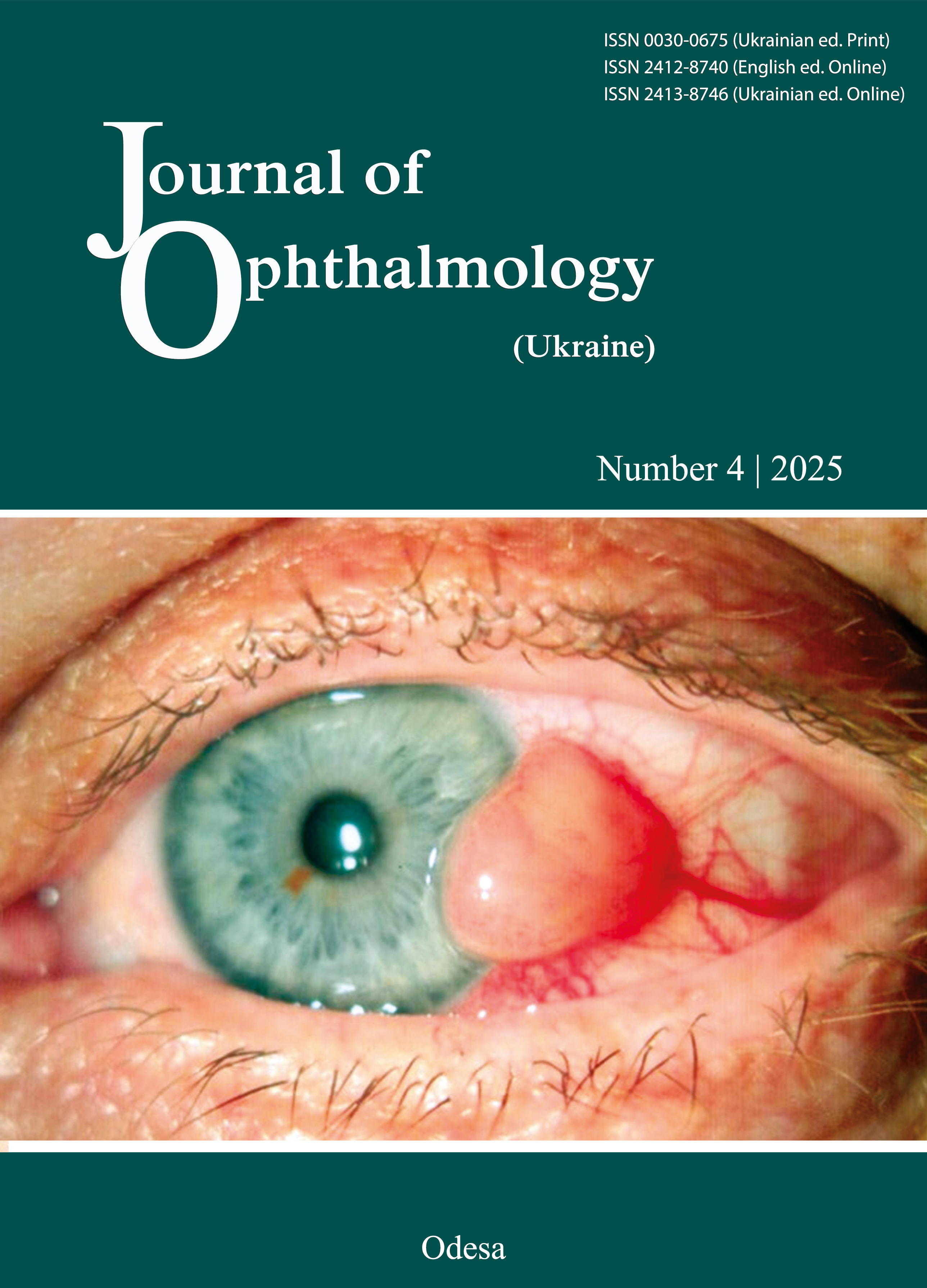Comparative Evaluation of Combined Therapy for Post-Thrombotic Retinopathy: Impact on Hypoxia Index and Retinal Parameters
DOI:
https://doi.org/10.31288/oftalmolzh202542429Keywords:
retinal vein occlusion, post-thrombotic retinopathy, macular edema, anti-VEGF therapy, micropulse laser, hypoxia indexAbstract
Introduction. Post-thrombotic retinopathy (PTR) is one of the most common retinal vascular diseases, complicated by the development of macular edema (ME) in 60-70% of patients. The main treatment methods include anti-VEGF therapy and laser photocoagulation; however, their efficacy is limited, and anatomical improvement does not always correspond to the restoration of retinal functional status. Therefore, there is a need to develop methods that allow for the objective assessment of hypoxic changes during therapy.
Purpose. To compare the effectiveness of combined anti-VEGF therapy and subthreshold micropulse laser treatment using a yellow laser (577 nm) versus anti-VEGF monotherapy in patients with post-thrombotic retinopathy, focusing on changes in the hypoxia index (Cg) as a functional biomarker, along with anatomical and visual outcomes.
Methods. The study included 60 patients (66 eyes) with PTR, divided into two groups: combined therapy (anti-VEGF + micropulse laser, 31 eyes) and anti-VEGF monotherapy (35 eyes). All patients underwent ophthalmological examination, optical coherence tomography (OCT), and electroretinography (ERG) with calculation of the Cg. Assessments were conducted at baseline and at 3, 6, and 12 months.
Results. By the twelfth month, central retinal thickness in the combined therapy group had decreased to 310±25 µm compared to 360±29 µm in the monotherapy group (p=0.006). Best-corrected visual acuity improved to 0.5±0.03 versus 0.33±0.03, respectively (p=0.003). The hypoxia index (Cg) significantly decreased from 5.6±0.32 to 5.27±0.25 in the combined therapy group, while no significant changes were observed in the monotherapy group (p=0.003).
Conclusion. Combined therapy using an anti-VEGF agent and subthreshold micropulse laser treatment promotes more pronounced anatomical and functional recovery of the retina in PTR. The use of the hypoxia index (Cg) provides an objective evaluation of therapy efficacy at the metabolic level and may be recommended for clinical practice.
References
Lendzioszek M, Bryl A, Poppe E, Zorena K, Mrugacz M. Retinal Vein Occlusion-Background Knowledge and Foreground Knowledge Prospects-A Review. J Clin Med. 2024 Jul 5;13(13):3950. https://doi.org/10.3390/jcm13133950
Hattenbach LO, Chronopoulos A, Feltgen N. Venöse retinale Gefäßverschlüsse : Intravitreale Therapien und Strategien zur Behandlung des Makulaödems [Retinal vein occlusion : Intravitreal pharmacotherapies and treatment strategies for the management of macular edema]. Ophthalmologie. 2022 Nov;119(11):1100-1110. German. https://doi.org/10.1007/s00347-022-01735-y
Patil NS, Mihalache A, Dhoot AS, Popovic MM, Muni RH, Kertes PJ. The Impact of Residual Retinal Fluid Following Intravitreal Anti-Vascular Endothelial Growth Factor Therapy for Diabetic Macular Edema and Macular Edema Secondary to Retinal Vein Occlusion: A Systematic Review. Ophthalmic Surg Lasers Imaging Retina. 2023 Jan;54(1):50-58. https://doi.org/10.3928/23258160-20221122-01
Patil NS, Dhoot AS, Nichani PAH, Popovic MM, Muni RH, Kertes PJ. Safety and Efficacy of a Treat-and-Extend Regimen of Anti-Vascular Endothelial Growth Factor Agents for Diabetic Macular Edema or Macular Edema Secondary to Retinal Vein Occlusion: A Systematic Review and Meta-Analysis. Ophthalmic Surg Lasers Imaging Retina. 2023 Mar;54(3):131-138. doi: 10.3928/23258160-20230221-04. Epub 2023 Mar 1. Erratum in: Ophthalmic Surg Lasers Imaging Retina. 2023 Jun;54(6):376. https://doi.org/10.3928/23258160-20230531-01
Gupta S, Thapa R, Pradhan E, Bajimaya S, Sharma S, Duwal S. Patterns of Macular Edema in Branch Retinal Vein Occlusion Diagnosed by Optical Coherence Tomography. Nepal J Ophthalmol. 2023 Jul;15(30):55-62. https://doi.org/10.3126/nepjoph.v15i2.29763
Hosoya H, Ueta T, Hirasawa K, Toyama T, Shiraya T. Subthreshold micropulse laser combined with anti-vascular endothelial growth factor therapy for diabetic macular edema: a systematic review and meta-analysis. Graefes Arch Clin Exp Ophthalmol. 2024 Oct;262(10):3073-3083.https://doi.org/10.1007/s00417-024-06460-7
Mi X, Gu X, Yu X. The efficacy of micropulse laser combined with ranibizumab in diabetic macular edema treatment: study protocol for a randomized controlled trial. Trials. 2022 Sep 2;23(1):736. https://doi.org/10.1186/s13063-022-06593-2
Kayhan B, Demir N, Sevincli S, Sonmez M. Electrophysiological and anatomical outcomes of subthreshold micropulse laser therapy in chronic central serous chorioretinopathy. Photodiagnosis Photodyn Ther. 2023 Mar;41:103221. https://doi.org/10.1016/j.pdpdt.2022.103221
Sabal B, Teper S, Wylęgała E. Subthreshold Micropulse Laser for Diabetic Macular Edema: A Review. J Clin Med. 2022 Dec 29;12(1):274.
https://doi.org/10.3390/jcm12010274
Gawęcki M. Subthreshold Diode Micropulse Laser Combined with Intravitreal Therapy for Macular Edema-A Systematized Review and Critical Approach. J Clin Med. 2021 Mar 31;10(7):1394. https://doi.org/10.3390/jcm10071394
Nagel I, Mueller A, Freeman WR, Kozak I. Laser-Based Therapy Approaches in the Retina: A Review of Micropulse Laser Therapy for Diabetic Retinopathy. Klin Monbl Augenheilkd. 2024 Nov;241(11):1201-1206. English. https://doi.org/10.1055/a-2418-5173
Majidova SR. Evaluation of Hypoxia and Microcirculation Factors in the Progression of Diabetic Retinopathy. Invest Ophthalmol Vis Sci. 2024 Jan 2;65(1):35. https://doi.org/10.1167/iovs.65.1.35
Neroev VV, Zueva MV, Tsapenko IV, et al. Functional diagnosis of retinal ischemia. Communication 1. Reaction of Muller cells at early stages of diabetic retinopathy.Vestn Oftalmol. 2004;120(6):11-13.
Neroev VV, Zueva MV, Tsapenko IV, et al. Functional diagnostics of retinal ischemia: muller cells and neovascularization of the retina in diabetic retinopathy. Vestn Oftalmol. 2005;121(1):22-24.
Nichani PAH, Popovic MM, Mihalache A, Pathak A, Muni RH, Wong DTW, Kertes PJ. Efficacy and Safety of Intravitreal Faricimab in Neovascular Age-Related Macular Degeneration, Diabetic Macular Edema, and Retinal Vein Occlusion: A Meta-Analysis. Ophthalmologica. 2024;247(5-6):355-372. https://doi.org/10.1159/000541662
Downloads
Published
How to Cite
Issue
Section
License
Copyright (c) 2025 Yusupov A.F., Karimova M.Kh., Djamalova Sh.A., Makhmudova Z.A.

This work is licensed under a Creative Commons Attribution 4.0 International License.
This work is licensed under a Creative Commons Attribution 4.0 International (CC BY 4.0) that allows users to read, download, copy, distribute, print, search, or link to the full texts of the articles, or use them for any other lawful purpose, without asking prior permission from the publisher or the author as long as they cite the source.
COPYRIGHT NOTICE
Authors who publish in this journal agree to the following terms:
- Authors hold copyright immediately after publication of their works and retain publishing rights without any restrictions.
- The copyright commencement date complies the publication date of the issue, where the article is included in.
DEPOSIT POLICY
- Authors are permitted and encouraged to post their work online (e.g., in institutional repositories or on their website) during the editorial process, as it can lead to productive exchanges, as well as earlier and greater citation of published work.
- Authors are able to enter into separate, additional contractual arrangements for the non-exclusive distribution of the journal's published version of the work with an acknowledgement of its initial publication in this journal.
- Post-print (post-refereeing manuscript version) and publisher's PDF-version self-archiving is allowed.
- Archiving the pre-print (pre-refereeing manuscript version) not allowed.












